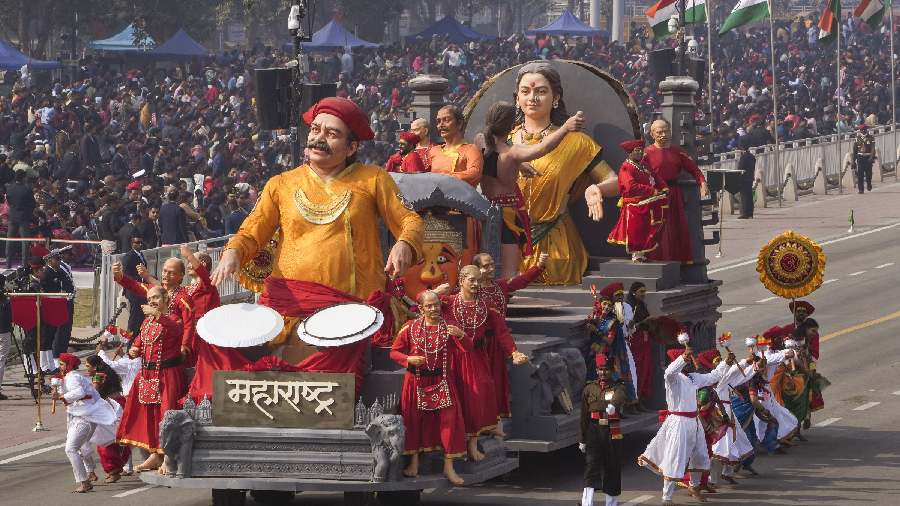"Nari shakti" and women empowerment dominated the theme of tableaux of Kerala, Karnataka, Tamil Nadu, Maharashtra and Tripura at the Republic Day parade here on Thursday.
Kerala presented the tableau of "Nari Shakti and Folk Traditions of Women Empowerment" that includes Kalaripayattu, a martial art with more than 2,000 years history, percussion and tribal traditions.
Kerala has the highest women's literacy rate in the country and has the world's largest women's self-help network, Kudumbashree. The tableau connected women empowerment with literacy mission.
The tractor portrayed Karthyayani Amma, the winner of Nari Shakti Puraskar in 2020 who topped the literacy examination at the age of 96. Nanchiyamma, the first tribal woman to bag the national film award in 2022 for best playback singing is seen saluting the nation.
Women are performing Kalaripayattu and the legendary Unni Archa who is known for expertise in Kalaripayattu in Kerala's folklore is portrayed at the top. Tribal dance from the Irula community is shown on the sides and Kudumbashree activities are showcased at the back portion.
Karnataka's tableau also celebrated the power of "nari shakti". Sulagitti Narasamma, a midwife, Tulsi Gowda Halakki, known as Vruksha Maate (mother of trees), and Salumarada Thimmakka (Thimmakka of row of trees) have become noted names due to their selfless contributions to the society.
The Centre honoured them with the Padma Shri, the country's fourth highest civilian award, for their outstanding achievement. In the foreground of the tableau was Sulagitti Narasamma, a midwife, rocking the cradle with a baby in it and playing with the children in her arms.
Narasamma is an expert in performing deliveries in a traditional way in the absence of skilled doctors. More than two thousand such deliveries have been performed by her in the last seven decades.
At the centre of the tableau was Tulsi Gowda Halakki, nurturing the plants. Tulsi is an expert in identifying and cultivating rare species of plants. She has the credit of planting more than 30,000 saplings. This is shown in the form of her sitting amidst the plants and nurturing them.
The last part of the tableau showed Salumarada Thimmakka, a tree planter, who planted 8,000 trees and watered them with the help of her husband along highways.
Tamil Nadu's tableau was based on women empowerment and culture of the state which prevailed from the Sangam era to the present day.
The front portion of the tableau showcased a statue of poet Avvaiyar, an icon for intellectual women. She wrote "Aathichoodi" and "Kondraiventhan" amongst several other finest poems. She is also known as a noble and worshipable saint of exponential morality.
On either side of the front portion, the statue of Veeramangal Velu Naachiar riding on a horse is placed. She was the queen of Sivaganga (1780-90), who stood as an epitome of bravery and waged war against the East India Company.
The middle portion of the tableau showcased statues of eminent women personalities namely Carnatic singer M S Subbulakhsmi, the great Bharatanatyam exponent Tanjore Balasaraswati, social reformer and doctor Muthulakhmi Reddy, author and political activist of the Dravidian Movement Moovalur Ramamirtham Ammaiyar and Pappammal, a popular organic farmer still active at the age of 105 in her agriculture field.
The rear portion of the tableau showcased the replica of Thanjavur Brihadeeswarar Temple built by Chola King Rajaraja Chozhan.
The temple is recognized as a UNESCO World Heritage Site.
On ground, the artistes were seen performing Karagaattam, along with a group of musicians in traditional attire playing Kombu (Horn), Naadaswaram and Thavil.
The tableau of Maharashtra on the background of Azadi ka Amrit Mahotsav presented "Sade Tin Shaktipithe and Nari Shakti".
Goddesses as sources of power was reflected through this tableau. In the front part of the tableau, the Ghondali associated with the goddess can be seen playing the instrument sambal. On the main body, one can see replicas of three and a half Shaktipeeths.
At the centre of the tableau there is a folk art form Potraj and Aaradhi, associated with the goddess. A Maharashtrian woman depicted on the back side of tableau represented feminine power.
Apart from that, folk art forms such as Bhop Bhutye, Jogwa are also shown on tableau.
Tripura tableau's theme also revolved around women's power. It highlighted sustainable livelihood through tourism and organic farming in Tripura with active participation of women.
The tableau depicted the Mahamuni Pagoda (Buddhist stupa) at the front. The middle part showed various indigenous performing art forms of Tripura such as homgiri momitete.
The composite culture of Tripura and participation of women in different fields were depicted through self-help groups women at work, women with baskets of pineapples, cottage, tea plantation workers and woman dressed in colourful traditional costumes walking alongside the tableau.
Except for the headline, this story has not been edited by The Telegraph Online staff and has been published from a syndicated feed.











